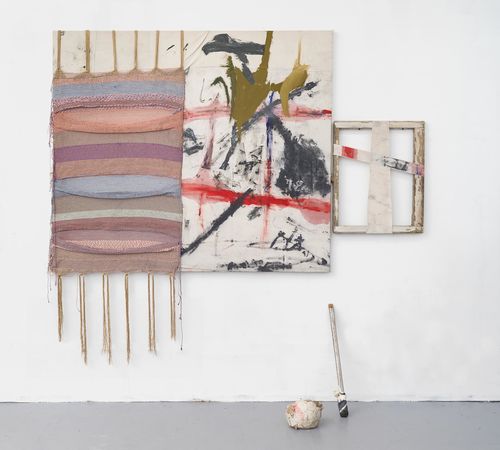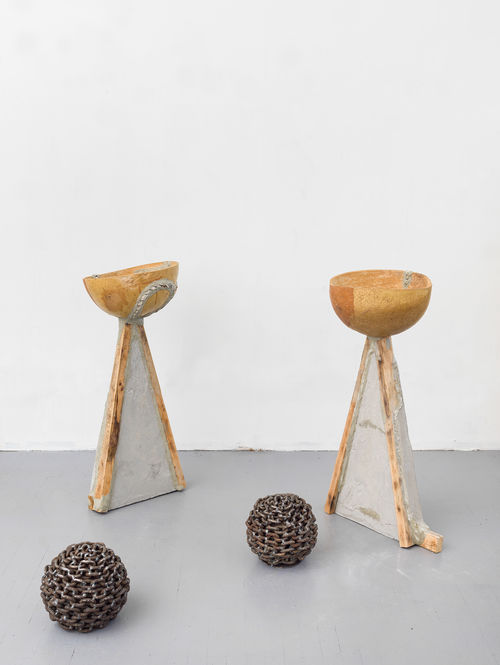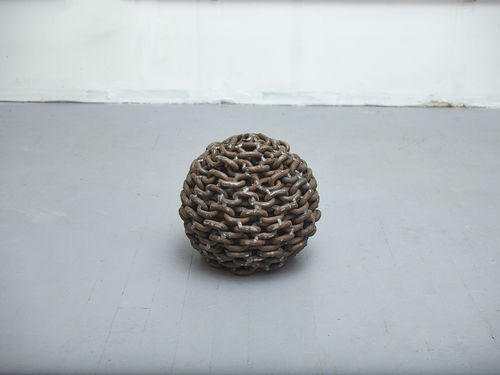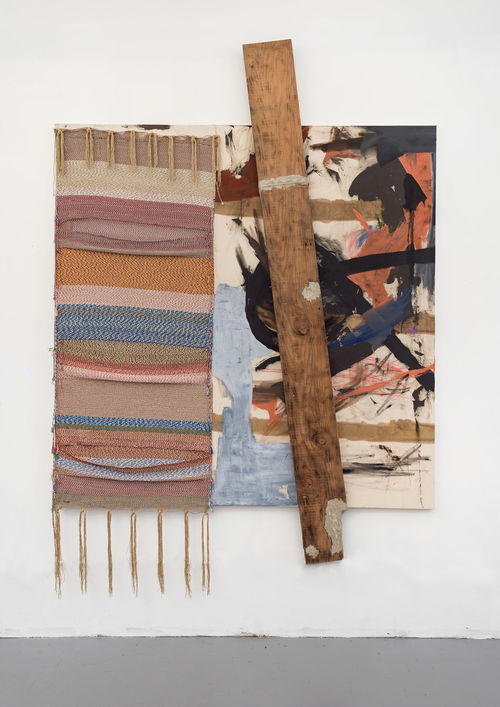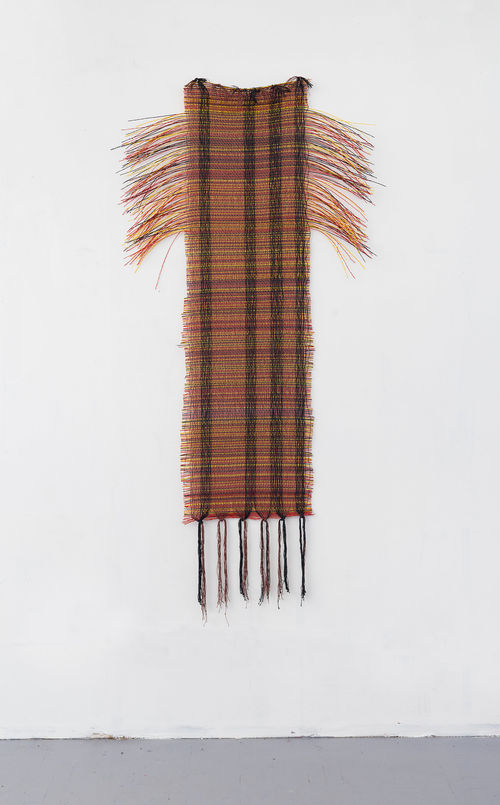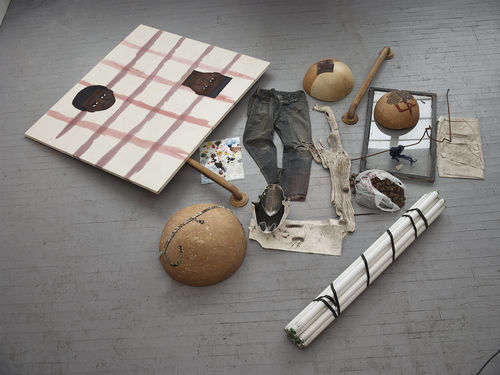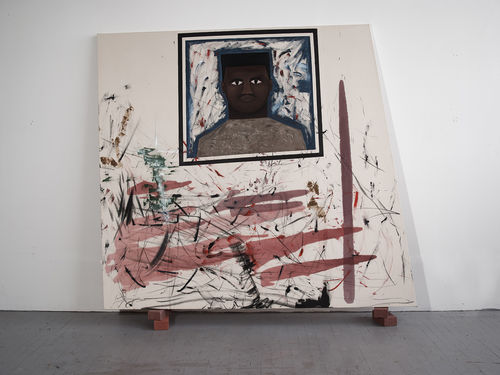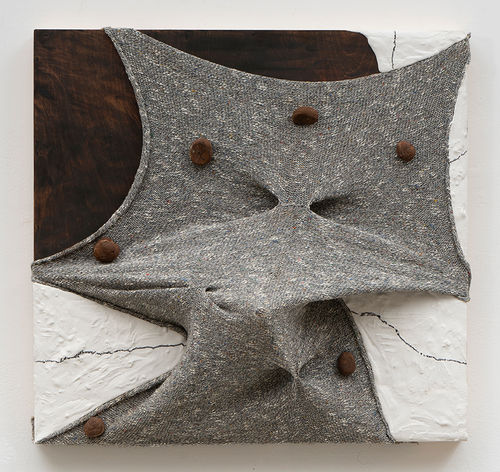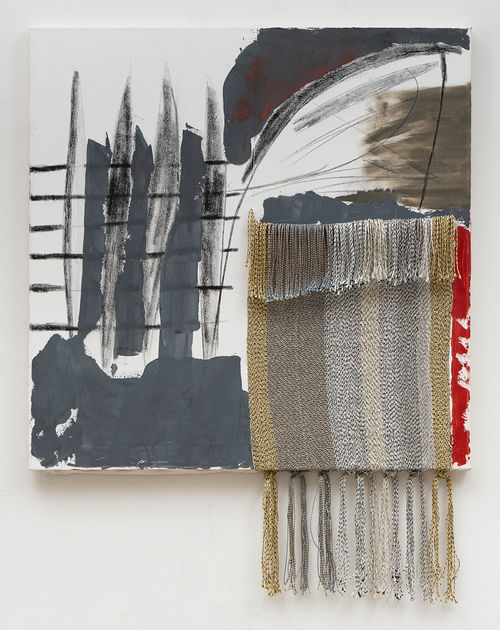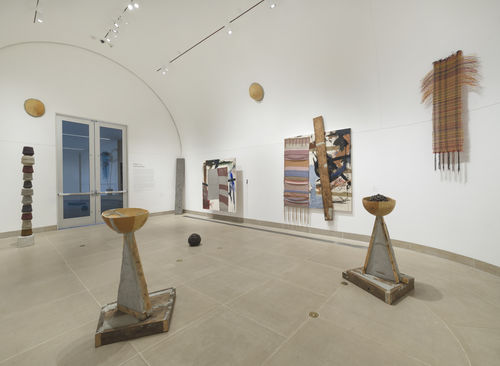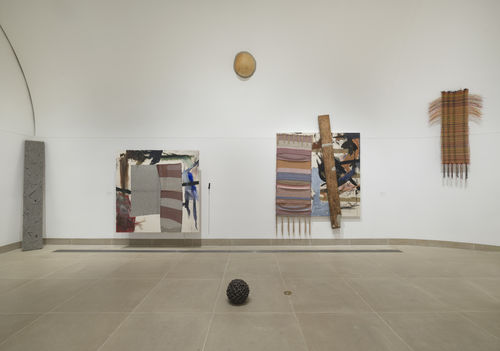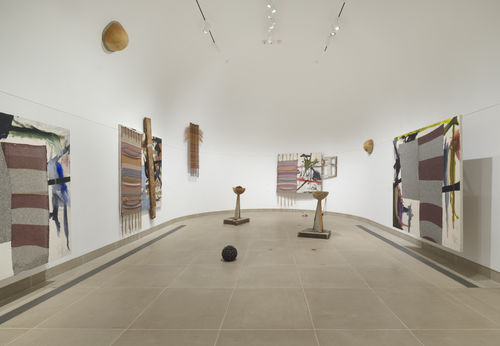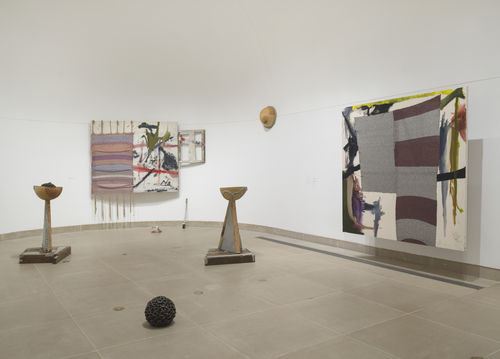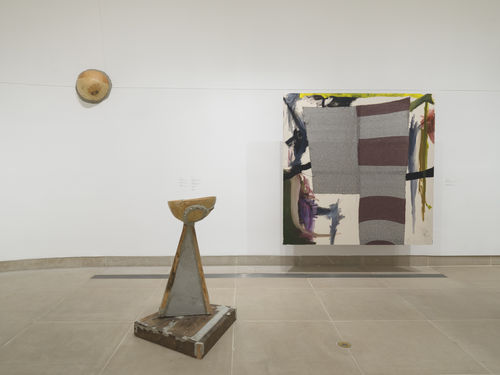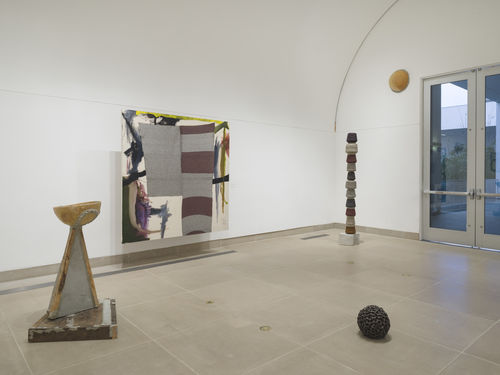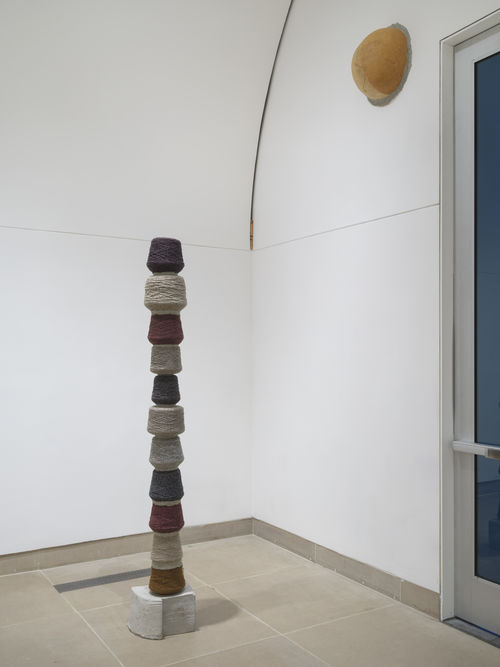
Hammer Projects: Vamba Bility
- – This is a past exhibition
Vamba Bility is a multidisciplinary artist whose work echoes the experience of the African diaspora. Having journeyed from Côte d’Ivoire to Guinea to the United States, Bility perceives this contested way of living as a blur, albeit one that is deeply intimate. In his hands, this blurred sensibility becomes a fluid movement that draws on various material histories. He expresses the reverberating motions of his existence by leaning on and weaving together mediums and materials such as painting, textiles, found objects, and sound. A cracked calabash gets sewn together. A torn canvas gets stitched as a salve. A painting is propped up by a brick or two. All of this is a form of mark making that structures the landscape of diaspora as a material residue of atmosphere, of feeling, of process. Bility threads this through a shared poesis—a bringing forth, a revelation—that sketches out an architecture of what it means to be.
At the Hammer Museum, Bility presents an array of objects, staging an aesthetic encounter that breathes life into his self-referential sketches of diasporic living. He structures the exhibition after the bustling bazaar—a dynamic space teeming with systems of exchange that produce, use, and reuse commercial materials like spools of yarn, bags of kola nuts, planks of wood, metal chains, and swaths of canvas. The resulting sculptures and paintings engage in a dialogue with the material concerns of several avant-garde practices of the 1960s and 1970s, including those of the Italian Arte Povera movement, and the West African sensibilities and strategies of Vohou-Vohou and récupération. To varying degrees, these ways of object making intentionally flatten the distinctions between local, imported, industrial, and natural materials.
The horizontal ethic embedded in Bility’s mark-making process informs how we grapple with painting traditions, sculptural forms, and the cathedral-like architecture of the Hammer’s Vault Gallery. The calabash gourds, roughly cemented onto the gallery walls, echo the curvature of the semicircular apse. The carbon char, a residue of burnt wood, offers tangible evidence of a painterly act. The softly muted oil washes draw attention to the gashes on the canvas. These probing layers of depth and texture, while partially serendipitous, function as a commentary on disobeying the disciplines of painting and sculpture in pursuit of a syntax of movement that seeks an unencumbered existence. Bility initiates this process of renaming through fragments that fall in and out of thought, form, materiality, and tradition.
Hammer Projects: Vamba Bility is organized by Ikechúkwú Onyewuenyi, curatorial associate, with Nyah Ginwright, curatorial assistant.
Essay
By Ikechúkwú Onyewuenyi
I’ve been in a race for theory. It’s like an obligation to care for the narratives surrounding Vamba Bility. I’ve been running this race despite Bility cautioning against doing so. I understand his hesitation, thanks to the writer and poet Derek Walcott, who warned against narratives “being corrupted into significance by . . .prose.”1 Walcott began his own “race . . . with no nouns, and with no horizon.” He also had “no memory” and “no future” on his race.2 Running from these subjective experiences ensured the horizon—i.e., history—didn’t sink Walcott’s mind into reductive, Eurocentric binaries. Bility has memories in Ivory Coast, Liberia, Guinea, and the United States. However, I see Bility engaging in a similar poetic strategy, where he angles his artistic practice, manipulating his painting, textiles, sculpture, and text-based works in such a manner that any “horizon sinks in the memory.”3 These sinking negotiations echo with the “race for theory” undertaken by writers like Alice Walker, Paule Marshall, and Toni Morrison. Their race, as highlighted by Black feminist scholar Barbara Christian, involves saving their lives through writing in a way that is “both sensual and abstract, both beautiful and communicative.”4 I glimpse these traces—sensual, abstract, beautiful, communicative—on the work Bility makes. Caring for these sightlines demands that I meditate on what an artist like Bility has had to do and be as he moves through moments in which he “sinks” under the existential weight of “memory.”5
These reflections on being emerge from the philosophical considerations guiding Bility’s artistic practice. Bility articulates that his making is “concerned with what it means to be and processing time. How that is encapsulated at the end is something I leave up to the work and the viewer.”6 This aesthetic exploration through objects constitutes an inquiry into the limits and possibilities of an ontology of Black life. Philosophers such as Fred Moten and Axelle Karera might argue that Bility’s undertaking is doomed from the outset. Moten is troubled by the “unintended racism” in phenomenology, which concerns both the immediate appearance of things and the subjective horizon of experience.7 The relationship between these entities and experiences falls under the purview of ontology. Meanwhile, Karera illuminates how the history of ontology manifest as “violent friendships” or the “ghastly proximity of a family one never chose.”8 This horizon of racialized dispossession must be considered alongside Bility’s movement away from intradiasporic conflict, particularly the First Ivorian Civil War (2002–7).
I see Bility’s experience of diasporic time following the war as an amalgam of déjà rêvé and presque vu—a dream that is at once familiar and revelatory. There exists a double movement on this horizon of experience, with Black life and Black art forever contending with exclusion and precarity within the realms of ontology. As Bility experiments with materials, he anticipates this prospect of failure, acknowledging that his mandate for making moves in and out of alignment with the slippery enterprise of ontology. Bility embraces this elusiveness via his meditations on the “atmosphere as a source to feel and process” during the “winter of weaving.” He goes on to reflect: “That feeling [of winter] . . . makes me think back to my [textile] training in undergrad and my upbringing in West Africa, as they relate to the atmosphere around this time of year.” I, too, know this feeling, this time, this atmosphere—the intermingling of pressure systems above the Gulf of Guinea and Sahara. I was born during Harmattan. I left Nigeria during Harmattan. Bility’s memories in his New England studio sink the horizon of the African diaspora, flooding it with his own contradictions. Even the weather evokes a multitemporal array of feelings that eclipses horizons. Bility finds solace in these phenomenological musings, for they remind him that what houses his memories—materials, anecdotes—is never inert, always epiphanous.9
But, for Bility, these reveries do reach a self-assured end or what philosopher Gaston Bachelard understands as a “cosmic negation in action,” which is to say that Bility is comfortable with the artwork breaking itself, erasing its existence, at the mercy of relations.10 This is apparent in the calabash gourds placed throughout the gallery. The gourd, a fruit dating to around 9000–8000 BCE, is hollowed, dried, and repurposed as a household utensil. Bility’s calabashes show cuts sewn over or sealed with epoxy clay and cement. Contemplating this history of aesthetics and archaeology—Bility’s “encapsulated end”—has the potential to efface not only the viewer but also the art itself. I interpret this dialogical process to making and meaning as a kind of ontological resistance or what Moten calls “the pressure blackness puts on both ontology and relation.”11 Certainly, one could construe the pressure as a physical gesture wielded by Bility when he’s making. But what if we perceive this pressure as a poetic force unfolding into a material dehiscence? Do we see the poetics in Bility’s cracked calabashes and torn canvases solely through a historical lens? Ralph Waldo Emerson proposed in his 1836 book Nature that no one “owns the landscape. There is a property in the horizon which no man has but he whose eye can integrate all the parts, that is, the poet.”12 I’d like to think Bility could be that kind of poet.
Bility jots down what he calls index notes—fragments of words that display a recursive structure, revisiting being and time. Index Notes No. 11 (2022) elucidates Bility’s journeys along I-95, Merrick Parkway, and the Metro North, where he gleans raw materials for his work. He pens, “Foggy night on the road / Some visible and some not /. . . / Oak trees are all dry now / The gods are here today.” These excursions extend Bility’s atmospheric musings in the studio. Mundane instances of travel, of “muds walking through these woods,” become surrealist windows into his accumulation of material. Bility doesn’t view these index notes as poems, but they bear a striking formal and conceptual similarity to “Song of the Andoumboulou,” a serial poem that Nathaniel Mackey began writing in the early 1970s. Mackey numbers each “Song”—there are hundreds now—as a marker of continuity and finitude, of humanity moving forward yet falling short. This repetitive gist with time and terminality is Mackey’s way of connecting with the Dogon people of Mali, who recognized the Andoumboulou as “an earlier draft of human being[s] that didn’t work out.”13 Despite their failings, Dogon cosmology and ethics mandate that we sing to these fallen humans. Bility isn’t necessarily calling for a communing with the dead, but he avoids dictating the encapsulated end to his work in a manner akin to Mackey, who doesn’t want “to present . . . something wholly synthesized and thought out, with no cracks and no gaps and no leaks and no ellipses.”14 Bility’s work is similarly defined by numerous cuts, openings that relate to others, which allow the sinking to begin and for memory to wreak havoc on certainty.
Bility’s Index Notes N. 43 (2023) consists of one to three words per verse, with only two instances where the count reaches seven words. These words are displayed on the front wall of the Hammer’s Vault Gallery, serving as an addendum for exhibition-goers moving through the space. I read the note as animating the possibility of its speech act. For instance, the line “Breaks here within Shadows of before here / Shadows, shadows” uses the word shadows as a noun and verb, unsettling semantic norms and grammatical function. But the kernel in Index Notes N. 43 is the comma splitting “Shadows, shadows” and the period at the end of the index note. These placements suggests an apposition—two noun phrases juxtaposed. Moten believes such appositional moves in prose and painting set the stage for “the discovery of . . . an almost hidden step (to the side and back).”15 Let’s go back, then, to Mackey’s “Song 2” draft, wherein he crafts a haptic account of what we might discover within “an enclosure” (or what Bility might call an “encapsulated end”). Mackey repeats this phrasing in the subsequent lines: “Each wave is as to grasp / is an enclosure. Wet sand and water / wet our feet, all / shore dissolves, / as at our / bed’s edge each / finger / works the ribs of / broken ships.”16 Whether articulated through words, outstretched hands, or feet touching the earth, Mackey and Bility propose that grappling with the indeterminable makeup of humanity is all part of a rough draft, a process of disinterring objects like broken ships, beds, and cones of wool from a questionable ontology.
Bility’s untitled work of 2023 is a cross-shaped textile of entwined cotton, wool, and polypropylene yarn. The symbolic connotations make it easy to see the woven narrative—threads traversing up and down, left to right—that represents the warp and weft of a weave. The connective nature of these threads unites the tapestry, giving the fabric a semblance of sturdiness, especially in the vertical stipe. At the edges of the would-be patibulum, or crossbar, of the crucifix, the yellow, red, and black yarn filaments dangle independently. This fraying also appears at the base of the stipe—another edge—where strands of black and brown cotton and wool are tied into six knots, leaving the remaining threads hanging loosely.
What does it mean to engage in the act of describing this work, to sit with its dense middle and unraveled edges? Roland Barthes, in a 1978 lecture, noted that “to describe = to unthread.”17 The core of this unthreading lies in the careful dissection, “thread by thread, to separate out the gold.” And what constitutes this gold? Barthes suggests our descriptive endeavors are “to live according to nuance.”18 I believe this ethic operates at the margins, where fabrics give under the tension of power and language. These constitutive forces coerce the public into a false sense of safety and security. Yet, as art historian Julia Bryan-Wilson notes, the politics of textiles at the “edges—or borders are more prone to fraying, as they are subject to more friction.”19 Following Barthes, this strife at the edges arises from our failure to loosen the “discursive forms” underlying knowledge production.20 This gets back to the act of describing, resisting the prescriptive, and welcoming the indeterminacy held within words and objects. But how loose can we get when Bility inhabits “the real” postcolonial catastrophes of Ivory Coast that aren’t always reducible to a “veil of fiction”?21 This diasporic line of inquiry converges with the Black feminist stance of Hortense Spillers, who posits that the “strategy of naming means different things to different viewers, depending on which border he is standing when evoking it.”22 Then again, Jacques Lacan’s saying that “truth has the structure of fiction” is a reminder that it’s not enough to pivot away from the fiction.23 Reality and fiction are two sides of the same coin, hardly separated by a veil. So let’s move with Moten again. To discover that “hidden step (to the side and back),” which is to say to tarry with fiction’s many sides, we’ve got to get at what cultural critic Susan Willis describes as “the very structure, the warp and weft of the veils.”24
I’m fascinated by how Bility makes the grain of the veil visible in this untitled work, which embodies his truth in a woven structure that steps to the side and back. The intricacy of this stepping manifests in the choice of yarn. He shared with me, “I’m thinking of each yarn as carrying its own weight, but also a certain type of history.”25 Around this time, I came across a video of Bility documenting a calabash bobbing and drifting in the Long Island Sound. Intrigued, I questioned Bility about this, and somehow we arrived at the buoyant properties of polypropylene yarn and how in the studio it doesn’t float as a single strand. I pressed further, asking about the yarns’ behavior when bound together, as in this woven cross. Bility coyly chuckled, “You’re grasping the weight of it all.”
History is another weight that carries its own truth yet is susceptible to myth. Bility knows this heft, given that his people hail from Ivory Coast, Liberia, and Guinea. I think of the countless African migrants swimming for their lives off the shores of Lampedusa—some surviving, many sinking. Consider the forty-five individuals who sailed from Sfax, Tunisia, on August 3, 2023. The four survivors—all from Ivory Coast and Guinea—were discovered on August 9, 2023. I imagine these events as the “certain type of history” Bility alluded to concerning polypropylene yarn. I can’t be sure. There are other histories. Take the Ivorian miracle—the economic boom that beguiled the Ivory Coast from the 1950s to 1990.26 Bility did not live through this miracle; he was born just as the golden era was ending with the death of Papa Houphouët. Do we sing for him, Le Vieux, the president of a one-party regime? Mackey would say yes. But the material ruins of the Ivorian miracle would inflect the song, give the yarn an illusory tone.
The so-called Ivorian economic miracle revealed itself as a mirage. Despite a surge in crop prices, peasant farmers experienced stagnant payouts during the euphoric years of 1960 and 1979. And by 1980, French, Dutch, and American firms dominated 70 percent of cocoa and coffee exports.27 Corruption aimed at profiting from these diminishing resources foreshadowed the outbreak of the First Ivorian Civil War in 2002. Bility’s movements during this wartime period, shuttling between Ivory Coast and Guinea before settling in the United States in 2005, embodied the geopolitical complexities of the Ivorian mirage. Historian Abou B. Bamba notes that starting in the postwar era, in the early 1960s, “the United States and other global forces had begun appearing in unoccupied interstices [in Ivory Coast].”28 By 1975, the Ivorian external public debt to the United States had climbed to $242 million. Despite talk of a second economic miracle, the Ivorian debt is now in the billions.29 Owing to these extractive American relations, I believe Bility has a right to the ecologies of displacement scattered about I-95 and Merrick Parkway.
Bility’s time at the Rhode Island School of Design and Yale University exposed him to other miracles that influenced the arc of art history. Arte Povera got going in Italy following the Miracolo italiano—the rapid post–World War II industrialization boom in the 1950s and 1960s that opened the floodgates of consumerism. The Wirtschaftswunder (economic miracle) in West Germany and Austria also unfolded during this era, reviving the fortunes of the German working class after the war. All these histories obliquely illustrate Karl Marx’s verdict that Europeans conceive of “religious illusion [as] the driving force of history.”30 What if we returned to the material, the actual thrust of these miracles? When Bility talks about these histories, he directs attention not to the artistic movements per se but to their material incursions on form—for instance, Jannis Kounellis’s “use of burlap . . . as an entrance to thinking.” If we similarly step back and to the side before Bility’s works, we’ll see that the material transformation of, say, the calabash is generatively questioning the forms we privilege after geopolitical conflict. Many of these conflicts are ongoing. Hence, this lifting of the miraculous veil gets us back to why Bility makes: to process these interwoven, temporal shifts within history and humanity.
So, while this miracle may tether Bility’s rematerialization of objects to economic tumult, civil wars, Arte Povera, and the I-95, I’m reminded of the race I’m on and how no horizon or noun is clearcut and seamless. That’s the audacity of symmetry—the unjust closure it imposes on the mind. In other words, when I look at Bility’s work, I see the seams, the closures, but, like Walcott, I still don’t see “that moment when the mind was halved by a horizon.” I see we’re still collectively failing, acquiescing, repeating, changing. Bility is no exception. Therefore, I’m here to sink with Bility, to sit alongside him, listen to what he calls his “different anecdotes and mundane moments based in reverie,” and keep on stepping toward ways to connect and disconnect from existence.
For Kasey Elise, thank you.
Notes
1. Derek Walcott, “The Antilles: Fragments of Epic Memory,” in Nobel Lectures, Literature 1991–1995, ed. Sture Allén (Singapore: World Scientific Publishing, 1997), 37.
2. Derek Walcott, “Names,” in Collected Poems: 1948–1984 (New York: The Noonday Press, 1992), 307.
3. Walcott, “Names,” 307.
4. Barbara Christian, “The Race for Theory,” Cultural Critique 6 (Spring 1987): 52, 62.
5. “I have never found that moment / when the mind was halved by a horizon.” Walcott metaphorically introduces the horizon, which symbolizes the historicizing rhetoric of the binary that he confronts in his writing. Walcott, “Names,” 307.
6. Unless otherwise specified, all Vamba Bility quotes are from his interview by Rachel S. Kay, “Artist Feature // Vamba Bility,” RSK Artworks, February 10, 2023.
7. Fred Moten, The Universal Machine (Durham, NC: Duke University Press, 2018), 9.
8. Axelle Karera, “Paraontology: Interruption, Inheritance, or a Debt One Often Regrets,” Critical Philosophy of Race 10, no. 2 (2022): 160.
9. “A house that has been experienced is not an inert box. Inhabited space transcends geometrical space.” Gaston Bachelard, The Poetics of Space, trans. Maria Jolas (Boston: Beacon, 1994), 47. Bility shared this quote early in our working relationship.
10. Bachelard, The Poetics of Space, 47.
11. Fred Moten, Stolen Life (Durham, NC: Duke University Press, 2018), 24.
12. Ralph Waldo Emerson, The Complete Works of Ralph Waldo Emerson: Nature Addresses and Lectures (Ann Arbor, MI: University of Michigan Library, 2006), 8.
13. Nathaniel Mackey, Paracritical Hinge: Essays, Talks, Notes, Interviews (Iowa City: University of Iowa Press, 2018), 293.
14. Mackey, Paracritical Hinge, 289.
15. Fred Moten, In the Break: The Aesthetics of the Black Radical Tradition (Minneapolis, MN: University of Minnesota Press, 2003), 34.
16. Nathaniel Mackey, Eroding Witness: Poems (Chicago: University of Illinois Press, 1985), 38.
17. Roland Barthes, The Neutral: Lecture Course at the Collège de France (1977–1978), trans. Rosalind E. Krauss and Dennis Hollier (New York: Columbia University Press, 2005), 11.
18. Barthes, The Neutral, 11.
19. Julia Bryan-Wilson, Fray: Art and Textile Politics (Chicago: The University of Chicago Press, 2017), 4.
20. Roland Barthes, “Lecture in Inauguration of the Chair of Literary Semiology, Collège de France, January 7, 1977,” trans. Richard Howard, October 8 (Spring 1979): 15.
21. Susan Willis, “Empire’s Shadow,” New Left Review 22 (July/August 2003): 64.
22. Hortense J. Spillers, Black, White, and in Color: Essays on American Literature and Culture (Chicago: University of Chicago Press, 2003), 31.
23. Jacques Lacan, “Columbia University: Lecture on the Symptom,” trans. Adrian Price with Russell Grigg, Culture/Clinic 1 (2013): 9.
24. Willis, “Empire’s Shadow”: 64.
25. Vamba Bility, message sent to the author via iMessage, December 29, 2023.
26. See Abou B. Bamba, African Miracle, African Mirage: Transnational Politics and the Paradox of Modernization in Ivory Coast (Athens, OH: Ohio University Press, 2016).
27. For these statistics, see Robert M. Hecht, “The Ivory Coast Economic ‘Miracle’: What Benefits for Peasant Farmers?,” Journal of Modern African Studies 21, no. 1 (March 1983): 25–53.
28. Bamba, African Miracle, African Mirage, chapter 4, epub.
29. Kim Yi Dionne and Abou Bamba, “Is Ivory Coast Seeing a Second ‘Economic Miracle’?, Washington Post, July 14, 2017, https://www.washingtonpost.com/news/monkey-cage/wp/2017/07/14/is-ivory-coast-seeing-a-second-economic-miracle.
30. Karl Marx and Frederick Engels, The German Ideology: Part One (New York: International Publishers, 2004), 60.
BIOGRAPHY
Vamba Bility (b. 1990, Côte d'Ivoire) lives and works in New Haven, Connecticut. His work has appeared in group exhibitions, including those at the Africa Center, New York (2022); Lyles & King, New York (2021); and The Kitchen, New York (2017). Bility received his BFA in textiles from Rhode Island School of Design and his MFA in painting/printmaking from Yale University School of Art.



